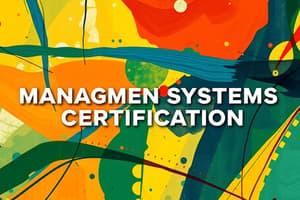Podcast
Questions and Answers
What is the primary goal of Management Information Systems (MIS) in a business?
What is the primary goal of Management Information Systems (MIS) in a business?
- To reduce costs and increase revenue
- To facilitate daily transactions
- To provide data for decision-making (correct)
- To support tactical decision-making
What type of communication is most effective for building strong customer relationships?
What type of communication is most effective for building strong customer relationships?
- Written communication
- Verbal communication (correct)
- Transactional communication
- Non-verbal communication
What is the primary benefit of effective communication in business?
What is the primary benefit of effective communication in business?
- Improved productivity and efficiency
- Enhanced customer relationships and satisfaction (correct)
- Reduced costs and expenses
- Increased revenue and profits
What type of system supports tactical decision-making in a business?
What type of system supports tactical decision-making in a business?
What is the primary purpose of Transaction Processing Systems (TPS) in a business?
What is the primary purpose of Transaction Processing Systems (TPS) in a business?
What is the primary goal of business administration systems?
What is the primary goal of business administration systems?
What type of business document is used for internal communication?
What type of business document is used for internal communication?
What is the outcome of personal and professional development on job performance?
What is the outcome of personal and professional development on job performance?
What is the significance of managing information in business decision-making?
What is the significance of managing information in business decision-making?
What is the primary function of planning in business administration systems?
What is the primary function of planning in business administration systems?
What type of business administration system interacts with the environment and adapts to changes?
What type of business administration system interacts with the environment and adapts to changes?
What is the importance of seeking feedback and mentorship in personal and professional development?
What is the importance of seeking feedback and mentorship in personal and professional development?
What is the primary purpose of minutes in business documentation?
What is the primary purpose of minutes in business documentation?
Flashcards are hidden until you start studying
Study Notes
Business Administration Systems
- Definition: Business administration systems refer to the management of business operations, resources, and activities to achieve organizational goals.
- Types of business administration systems:
- Open systems: interact with the environment and adapt to changes.
- Closed systems: do not interact with the environment and are self-contained.
- Functions of business administration systems:
- Planning: setting goals and objectives.
- Organizing: allocating resources and assigning tasks.
- Staffing: recruiting, training, and developing personnel.
- Directing: leading and motivating employees.
- Controlling: monitoring and correcting performance.
Business Documents
- Definition: Business documents are written records used to communicate information, provide evidence, or facilitate transactions.
- Types of business documents:
- Memorandums (memos): internal communication.
- Reports: formal documents providing information or analysis.
- Proposals: suggestions or offers for business opportunities.
- Invoices: requests for payment.
- Minutes: records of meetings.
Personal And Professional Development
- Definition: Personal and professional development refers to the process of improving skills, knowledge, and attitudes to achieve career goals.
- Importance of personal and professional development:
- Enhances job performance and productivity.
- Increases job satisfaction and motivation.
- Supports career advancement and promotions.
- Improves adaptability to changing work environments.
- Strategies for personal and professional development:
- Continuous learning and training.
- Seeking feedback and mentorship.
- Setting goals and objectives.
- Networking and building relationships.
Managing Information
- Definition: Managing information refers to the process of collecting, storing, retrieving, and utilizing data to support business decisions.
- Importance of managing information:
- Supports strategic decision-making.
- Enhances business efficiency and productivity.
- Improves customer service and relationships.
- Reduces costs and increases revenue.
- Types of information systems:
- Management information systems (MIS): provide data for decision-making.
- Transaction processing systems (TPS): facilitate daily transactions.
- Decision support systems (DSS): support tactical decision-making.
Communication In Business
- Definition: Communication in business refers to the exchange of information, ideas, and messages within and outside the organization.
- Importance of communication in business:
- Facilitates collaboration and teamwork.
- Enhances customer relationships and satisfaction.
- Supports decision-making and problem-solving.
- Improves productivity and efficiency.
- Types of communication in business:
- Verbal communication: face-to-face or spoken communication.
- Non-verbal communication: body language, tone, and facial expressions.
- Written communication: emails, reports, and documents.
Business Administration Systems
- Business administration systems manage business operations, resources, and activities to achieve organizational goals.
- Open systems interact with the environment and adapt to changes, while closed systems do not interact with the environment and are self-contained.
- The functions of business administration systems include planning, organizing, staffing, directing, and controlling.
Business Documents
- Business documents are written records used to communicate information, provide evidence, or facilitate transactions.
- Types of business documents include memorandums, reports, proposals, invoices, and minutes.
Personal and Professional Development
- Personal and professional development improves skills, knowledge, and attitudes to achieve career goals.
- It enhances job performance and productivity, increases job satisfaction and motivation, supports career advancement, and improves adaptability to changing work environments.
- Strategies for personal and professional development include continuous learning, seeking feedback and mentorship, setting goals, and networking.
Managing Information
- Managing information involves collecting, storing, retrieving, and utilizing data to support business decisions.
- It supports strategic decision-making, enhances business efficiency and productivity, improves customer service, and reduces costs.
- Types of information systems include management information systems (MIS), transaction processing systems (TPS), and decision support systems (DSS).
Communication in Business
- Communication in business is the exchange of information, ideas, and messages within and outside the organization.
- It facilitates collaboration and teamwork, enhances customer relationships and satisfaction, supports decision-making, and improves productivity.
- Types of communication in business include verbal, non-verbal, and written communication.
Studying That Suits You
Use AI to generate personalized quizzes and flashcards to suit your learning preferences.




